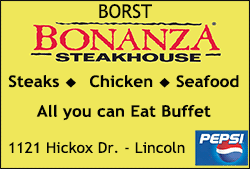|
 The Illinois Route 66 Scenic Byway is pleased to share the
information provided by the National Park Service, Route 66 Corridor
Preservation Program (https://www.ncptt.nps.gov/rt66/2016-cost-share-
grants-announced/). The announcement comes at a special time in U.S.
history, with 2016 being the 100th anniversary of the National Park
Service and the 90th anniversary of Route 66. The Illinois Route 66 Scenic Byway is pleased to share the
information provided by the National Park Service, Route 66 Corridor
Preservation Program (https://www.ncptt.nps.gov/rt66/2016-cost-share-
grants-announced/). The announcement comes at a special time in U.S.
history, with 2016 being the 100th anniversary of the National Park
Service and the 90th anniversary of Route 66.
From the National Park Service, Route 66 Corridor Preservation
Program, here is the information on the Illinois recipients:
Rialto Square Theatre Marquee Restoration Project
Location: Joliet
Total Grant amount: $55,710
“The Rialto Square Theatre in Joliet, Illinois, was built on an
original alignment of Route 66 in May of 1926, just six months
before the National Highway Act of November 11, 1926 ushered the
Mother Road into existence. These two entities – (1) an ornate
vaudeville stage and movie palace dispensing “talkies” to a gleeful
American public, and (2) a national highway designed to accommodate
the new automobile “fad” – would become important elements of US
culture from those days forward.
 Known as the Jewel of Joliet the theatre was constructed to spare no
expense. The building’s style was a wildly eclectic mix of Greek and
Roman Neoclassical Rococo, Italian Renaissance, and Art Deco, among
others. Every detail of the theatre was more ostentatious than the
next, and it was touted as “one of the world’s wonder theatres.”
By the 1970’s both Route 66 and the Rialto had fallen into disrepair
as Route 66 was bypassed and by the Interstate Highway System. By
1978 the Rialto was targeted for demolition to make way for a
parking lot. In response the Will County Cultural Arts Association
was created to save the theatre from the wrecking ball. They listed
the property on the National Register of Historic Places, and by the
1980s restored the theatre back to operating condition. The theater
has served as a matinee and community center ever since, welcoming
over 100,000 visitors a year.
Watching over Route 66 for nearly a century is the Rialto’s
distinctive, seven-story vertical neon sign and marquee, which have
heralded films and events to residents and travelers alike. Grant
funds will assist with the restoration of the marquee to its 1926
appearance.”
The Mill on Route 66
Accessibility Project
Location: Lincoln
Total Grant amount: $22,720
“The Mill Restaurant in Lincoln, Illinois, is a prime example of
early American roadside architecture, and is one of the few
buildings from the era still standing. The restaurant was first
opened on Route 66 in 1929 under the name of the Blue Mill. The
eatery was constructed by local contractors in the shape of a small
Dutch windmill with sails on the front. It was white with blue trim,
with continuously turning sails decorated with lights.
In 1945 an army barrack from Camp Ellis was attached to the back of
the building to accommodate a restaurant, bar, and dance hall. It
was then that the entire building was painted red and renamed The
Mill. One of the restaurant’s claims to fame was its fried
schnitzel. The Mill also offered a display of strange objects to
attract and entertain customers: a mechanical leg kicked its way
through a hole in the ceiling; four life-sized figures, a suit of
armor, and a 20- pound stuffed catfish were on display; and a basket
above the bathroom door – when opened – would blast a loud siren
throughout the restaurant.

The Mill closed in 1996 and stood deteriorating for many years. In
2006 the Route 66 Heritage Foundation of Logan County was created to
promote and preserve the Mill and other Route 66 sites in Logan
County. The foundation worked with the City of Lincoln to save the
building from the wrecking ball and gain title to the property. The
foundation has been working to restore the National
Register-eligible property to a museum and visitor center ever
since. A NPS grant in 2008 helped with structural repairs. The
current grant will provide accessibility to the building including
an entrance and bathroom. The original basket and loud siren that
once adorned the bathroom door will also be restored.”
Del Rhea’s Chicken Basket Neon Sign Restoration Project
Location: Hinsdale
Total Grant amount: $34,600
“The Chicken Basket began in the 1930s as a lunch counter attached
to a service station in then- rural Hinsdale, Illinois. This mix and
match of functions was typical for Route 66 establishments, which
often operated on very thin profit margins that required them to be
creative in attracting customers.
[to top of second column] |

Legend has it that in the late 1930s two local farm women offered a
deal to original owner Irv Kolarik, who was looking to expand his
food menu. They would reveal their excellent fried chicken recipe to
Mr. Kolarik and his customers if he would promise to buy the
necessary chickens from them. To sweeten the deal the women offered
to teach him how to actually fry the chicken. Soon, the service
station was history and the Chicken Basket was born. The
restaurant we see today was built in 1946 adjacent to the original
location of the 1930s station. The one-story brick building was
constructed in a no-nonsense, utilitarian commercial style of the
immediate postwar period. Overall, the restaurant retains much of
its original 1946 appearance and is listed on the National Register
of Historic Places. The restaurant has a flat, steel roof that did
double duty in the 1950s; to attract customers, Mr. Kolarik flooded
the roof in winter and hired youths to ice skate on top of the
building.
The restaurant flourished, but like many other successful businesses
along Route 66, the Chicken Basket faced a serious challenge with
the coming of the interstate in 1962. However in
1963, Delbert (Dell) Rhea, a savvy Chicago businessman, purchased
the restaurant and turned things around through aggressive
advertising aimed at Chicago’s expanding suburban population as well
as Route 66 travelers. Today the restaurant continues to flourish.
NPS grant funds will assist with restoration of the neon sign.”
Sprague’s Super Service Rehabilitation Project
Location: Normal
Total Grant amount: $31,398
“The brainchild of William W. Sprague, the two-story, Tudor Revival
style Sprague’s Super Service on Route 66 in Normal, Illinois, was a
combination cafe, filling station, and service station, built toward
the beginning of the Depression to provide service and food to
travelers. The second story of the building provided housing for
both Mr. Sprague and for the service station attendant.

The Sprague’s Super Service is an excellent model of preservation
through partnership. In 2003, the current owner began the
preservation process by listing the property on the National
Register of Historic Places. The owner then applied for grant funds
from the National Park Service Route 66 Corridor Preservation
program to develop a preservation plan and to address urgent
needs/repairs. With the preservation plan in hand, the owner was
able to appeal to the City of Normal for additional funds to assist
with repairs to the roof and heating system. Because of this
positive track record, the owner next applied for and received
additional grant funds for heating and air conditioning work from
the Illinois State Tourism Department. In addition, the owner
arranged for volunteer work days at the station involving the
Illinois Route 66 Association. In 2011, the building was designated
as a local landmark by the Town of Normal, and in 2016, the town
voted to acquire the property to secure is preservation and
protection. Now known as Ryburn Place, the goal is to open the
property as a Route 66 visitor center.
Following a preservation plan prepared in 2009 a new roof and
bathrooms have been installed, and the historic, wood frame windows
and doors have been rehabilitated. The NPS grant will help repair
and stabilize the exterior stucco and masonry and rehabilitate the
last of the windows.”
For additional information, visit
https://www. ncptt.nps.gov/rt66/2016-cost-share-grants-announced/,
or search the National Park Service, Route 66 Corridor Preservation
Program grant database at
http://ncptt.nps.gov/rt66/grant-projects/.
[2016 National Park Service Route 66
Corridor Preservation Program]

 |